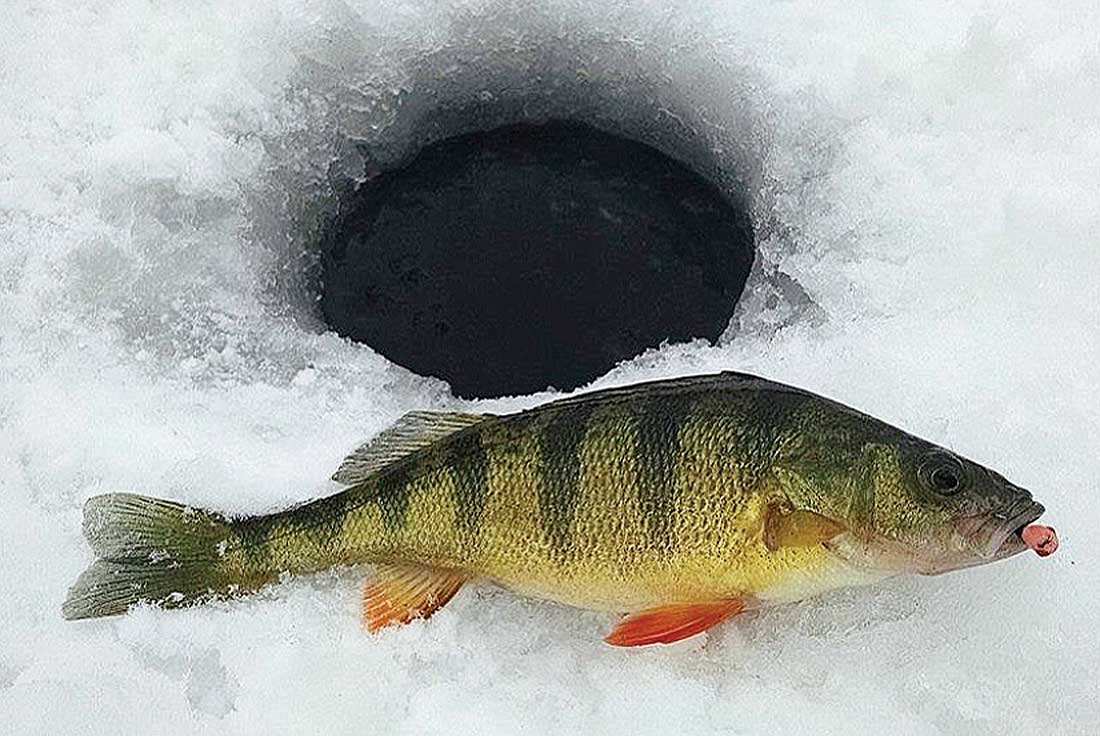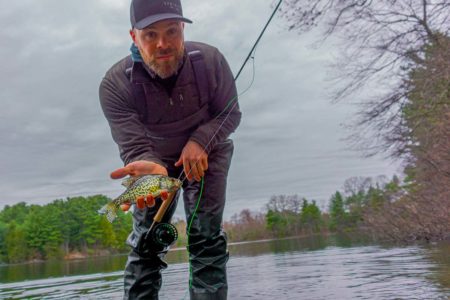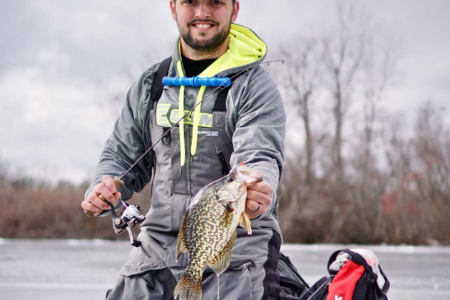
Extend the hot bite of early ice by altering your presentation and location to adapt to specific panfish preferences.
Getting out early on the ice each season is everyone’s goal. We all would like the first crack at those fish that have gone pretty much unbothered for the past month or more. Initially fish still move around quite a bit and are very active. With stable oxygen levels throughout lakes and ponds, it can be a mixed-bag of fish at the end of the day as our finned friends keep cruising. Finding fish can be relatively easy if you set up on the right location. Crappie generally like deep basins in 25 to 30 feet of water, while perch like mud/gravel and weedy flats in 20 feet of water or less. So anglers usually set up accordingly to target a certain species. However, if you find the spot where those two types of bottom meet, you will catch a lot of fish in transition. It is all about connecting the dots in order to catch more fish.
In well-known places anglers set up shop consistently in the same areas once they find fish. This kind of pressure can make it difficult to fill your pail after a few weeks as fish wise up and the schools get fished down. Making the right adjustments will be imperative to your success whether it be your location, bait or time of day. I’ve found that areas that go from weedy flats and drop off into deeper water are key points. Fishing that ledge can produce big time after things start to slow down in those “community fishing hole” areas that I mentioned before. Some people stay sitting on those holes even as things slow down, and that’s just fine, but if you want more, you’ve got to move.

A steep drop-off provides a good ambush point for fish that hold there. It is also a route that connects the two areas where activity remains even in a bit more shallow water as long as the weeds stay healthy and green. Once the weeds turn brown they do not put out high oxygen levels and those areas will not be favorable as the food chain breaks down. The fish you’re targeting and any bait that the fish feed on will move. So moving on and most likely going deeper will be the answer. Finding healthy weed beds is the key if you want to keep your rod bent.
As they say, timing is everything. Being in the right place at the right time plays a huge role in your success. This isn’t anything new, but behaviors are different during the winter compared to the rest of the year. Knowing where and why your target species is where it is becomes very important, especially after they feel the heat from anglers harassing them for a while. Crappie push down into deeper basin areas, and anglers pound these spots the most. You will almost always find fish, but to find the better quality you need to understand them. Large crappie hold in these basin areas near any kind of structure, whether it be a brush pile or rock. They also tend to gorge themselves during low-light hours, and then hunker back down on that same structure. Any flats within a football field away from their holding areas will be their feeding grounds. Setting up on that transition area is a good in-between to cut them off as they pass through. Further, these areas are often overlooked by regulars who stick to weed beds and/or basins, but never work the water in-between.

Big gills and other sunfish tend to mix-in with crappie and can be found in thick weed beds and weedy flats. However, they will slide into those deeper basins with crappie as the season progresses and weeds die-off. Perch, on the other hand, are a bit different. Much more aggressive and less cautious than other panfish, they provide great action. I find a lot of perch in 10 to 20 feet of water. Gravel, mud and sandy areas near drop-offs are where they like to stage as it is easy to blitz baitfish that cruise these locations. Perch are no strangers to digging in the bottom either. They love gobbling up insect larva that come to life in muddy flats and under root vegetation during late season. For this reason, matching that food source is a good idea even early on because it is a known food source.
Bluegill seem to take advantage of these feeding frenzies, too. Once the mud gets stirred up a bit the switch can flip quickly. Fishing small tungsten jigs tipped with a realistic soft plastic is easy enough, and there are a ton of options out there on the market. There are some that just have a nice action and others that imitate a natural food source. I like to focus on the latter of the two, and the Gamma Scud from Eurotackle is a killer on the ice. Great profile and action also makes it easier to probe each hole without having to re-bait constantly when dinks start to nip at your presentation. Scuds are an important food source for many fish, and sending a look-alike down the hole will get you noticed. Pounding the bottom a little bit can stir things up and engage fish even from a distance. You can always pack on the meat with some waxies if you have some picky eaters down below, though.
First off, tungsten is denser than lead, so lures made out of it can be much smaller than lead ones of equal weight. Being heavy makes it easy to smash through the slush and ice that can build up, and it also plummets down to the bottom quicker, which enables you to get back down fast when the bite is hot. Sometimes it can be an all-out blitz that fizzles out fast and the heavy metal gets you back in the strike zone quickly. Being heavy means they are also loud. Northland’s Buckshot and Forage Minnow spoons are classic choices, and the T-Flasher is another great option. There are a lot of different spoons out there for hard water. I carry a variety because they’re so basic yet so effective, and they each have their own unique characteristics; some drop straight down while others flutter. There is a time and a place for them all.
Last, but certainly not least, feed panfish some hard candy! Jigging hard baits for big panfish is one of my absolute favorite things to do in the winter. I’m used to doing it for smallies on my home lake, and I quickly found it to be extremely effective for large panfish too. Generally with a bit bigger bait you will weed out the runts, and when you get hit it’s usually a big one. A few of my favorite hard baits for hard water are the classic Jigging Rap and Jigging Shad Rap from Rapala. I like the Jigging Shad Rap more because it has a more intense action than the original Jigging Rap and it is also slightly smaller in size. The more erratic action and slower circling fall seals the deal. The Rippin’ Rap has been a go-to for me for bass for years, but it can be a tad big sometimes for panfish.

The newest hard bait to my ice arsenal is the Z-Viber. A unique design that displays a pronounced darting action that rattles away, more often than not it is snatched up on the slow descent. This bait has been more productive for me with crappie and gills while the Rapalas really clean-up on the perch. Crappie can be very picky eaters at times, and if your bait falls past them too quickly, or maybe it just doesn’t fall right, crappie may not bite. They are definitely more particular than perch or even gills.
So widen your tackle selection this season and know where to find fish after the initial angling pressure is on. Try those transition points, and don’t be afraid to move around a bit to find the fish. Remember that timing is everything as well. With that knowledge and added weapons of hard baits, tungsten and soft plastics, you’ll be ready to go as the ice season enters its final stage.




